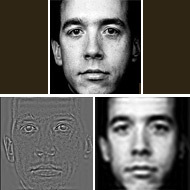
|
| ©James Feusner |
| Here's looking at you.
Normal (top), blurry (lower right), and high-spatial-resolution faces. |
Psychiatrist James Feusner and colleagues at the University of California, Los Angeles, asked BDD subjects and controls to scrutinize images of faces while their brains were being scanned by functional magnetic resonance imaging. Each face was presented in three versions: One was an unaltered photograph; one included only low-spatial-frequency information, resulting in a blurred image that yielded just a general impression of the face; and the third contained only high-frequency information, which exaggerated the lines of the face (see picture).
Previous research has shown that different neural pathways process high- and low-frequency information. When the image is blurry, the normal brain analyzes the face as a whole, whereas with high-frequency data, it zeroes in on details. The scientists found that the control subjects used a more holistic, right-brain strategy for the unaltered face and the low-frequency one. They only moved to the high-detail strategy for the high-detail face. In the BDD group, however, subjects failed to look at the figure as a whole, instead using left-brain channels that dwell on details for all three faces.
Feusner says the people with BDD don't have defective vision, as shown by the fact that there were no differences between the two groups in the activity of the occipital lobe, the brain's primary visual area. The differences show up in their "extended visual processing network," indicating that perceptions get twisted beneath the level of emotion or conscious thought, says Feusner, whose report appears in the December issue of the Archives of General Psychiatry.
Sanjaya Saxena, a psychiatrist at the University of California, San Diego, says that as a rule, psychiatrists have assumed that the distorted perceptions of people with BDD only related to how they view themselves. This study indicates that these distortions go deeper to include perceptions of others, he says. That helps explain why the disorder seems so "ingrained," Saxena says, and suggests that in addition to measures to reduce anxiety and depression, people with BDD might benefit from behavioral therapy aimed at "retraining" their visual processing. Feusner's team is now enrolling patients for the next stage of the study: seeing how patients react to altered and unaltered pictures of themselves.



Reader Comments
to our Newsletter